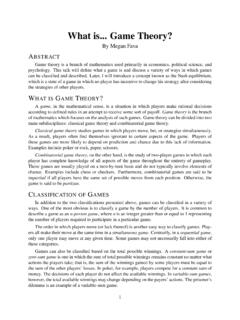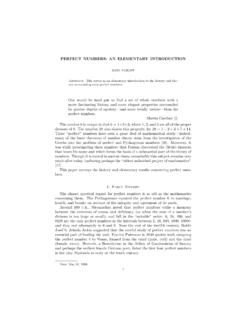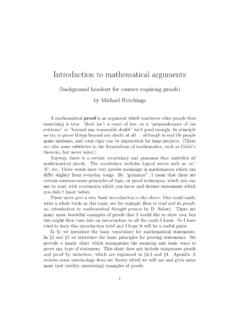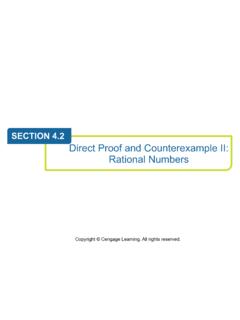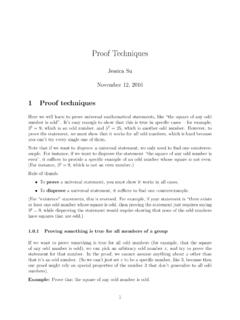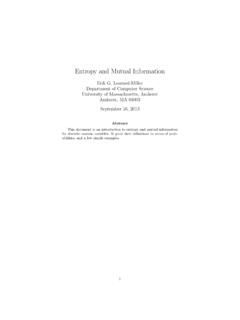Transcription of WHAT ARE THE BERNOULLI NUMBERS?
1 WHAT ARE THE BERNOULLI NUMBERS? C. D. BUENGER. Abstract. For the "What is?" seminar today we will be investigating the BERNOULLI numbers. This surprising sequence of numbers has many applications including summing powers of integers, evaluating the zeta function, finding asymptotics of Stirling's formula, and estimating the harmonic series. We investigate properties of these numbers and introduce BERNOULLI polynomials, a closely related topic. Then, we establish the Euler summation formula and use the formula to provide the aforementioned applications. Furthermore, a study of the Fourier coefficients, yields surprising results on the zeta function.
2 1. Introduction BERNOULLI numbers first appeared in a post humorous publication of Jakob BERNOULLI (1654-1705) in 1713, and were independently discovered by Japanese mathematician Seki Ko wa in 1712. BERNOULLI observed these numbers in the course of his investigations of sums of powers of integers. That is sums of squares, cubes, or higher powers. Let n 1. X. S p (n) = k p. k=1. We have the following closed forms of S p (n) for small p: S 0 (n) = n S 1 (n) = 1 2. 2n 1. 2n S 2 (n) = 1 3. 3n 1 2. 2n + 1. 6n S 3 (n) = 1 4. 4n 1 3. 2n + 1 2. 4n S 4 (n) = 1 5. 5n 1 4. 2n + 1 3. 3n 1. 30 n S 5 (n) = 1 6. 6n 1 5. 2n + 5 4. 12 n 1 2. 12 n S 6 (n) = 1 7.
3 7n 1 6. 2n + 1 5. 2n 1 3. 6n + 1. 42 n S 7 (n) = 1 8. 8n 1 7. 2n + 7 6. 12 n 7 4. 24 n + 1 2. 12 n S 8 (n) = 1 9. 9n 1 8. 2n + 2 7. 3n 7 5. 15 n + 2 3. 9n 1. 30 n S 9 (n) = 1 10. 10 n 1 9. 2n + 3 8. 4n 7 6. 10 n + 1 4. 2n 3 2. 20 n S 10 (n) = 1 11. 11 n 1 10. 2n + 5 9. 6n n7 + n5 1 3. 2n + 5. 66 n Date: July 13, 2013. 1. Through slight manipulations BERNOULLI arrived at the following reformulation of these sums: . S 0 (n) = 1 1. 1" 0 n 2 #. S 1 (n) = 1 2 2. 2 0 n 1. 1 2n " 3 3 #. S 2 (n) = 1 3 3. 3 0 n 1 2. 1 2n + 1. 2 6n " 4 4 #. S 3 (n) = 1 4 4. 4 0 n 1 3. 1 2n + 1 2. 2 6n " 5 5 5 #. S 4 (n) = 1 5 5. 5 0 n 1 4. 1 2n + 1 3. 2 6n 4 30 1. n " 6 6 6 #.
4 S 5 (n) = 1 6 6. 6 0 n 1 5. 1 2n + 1 4. 2 6n 1 2. 4 30 n " 7 7 7 7 #. S 6 (n) = 1 7 7. 7 0 n 1 6. 1 2n + 1 5. 2 6n 1 3. 4 30 n + 6 42 1. n " 8 8 8 8 #. S 7 (n) = 1 8 8. 8 0 n 1 7. 1 2n + 2 6 12n 4 30 n 1 6 1 4. + 6 42 n 1 2. " 9 9 9 9 9 #. S 8 (n) = 1 9 9. 9 0 n 1 8. 1 2n + 1. 2 6 3n 7 1 5. 4 30 n + 6 42 n 1 3. 1. 8 30 n " 10 10 10 10 10 #. S 9 (n) = 10 1 10 10. 0 n 1 2. 1 9. n + 2 6. 1 8. n 4 30. 1 6. n + 6 42. 1 4. n 8 30. 1 2. n " 11 11 11 11 11 11 #. S 10 (n) = 111 11 11. 0 n 1 2. 1 10. n + 2 6. 1 9. n 4 30. 1 7. n + 6 42. 1 5. n 1 3. 8 30 n + 5. 10 66 n Through this reformulation we notice the repeated occurrence of certain numbers within the closed form sums.
5 These are the BERNOULLI numbers. Here are the first few: 1 1 1. B0 = 1, B1 = , B2 = , B3 = 0, B4 = , B5 = 0, 2 6 30. 1 1 5. B6 = , B7 = 0, B8 = , B9 = 0, B10 = , B11 = 0. 42 30 66. More generally, via the Euler summation formula, we will prove that m 1 X m+1. ! (1) S m (n) = Bk nm+1 k (Here Bk is the kth BERNOULLI number ). m + 1 k=0 k We also achieve the results on the value of the zeta function on even integers and the asymptotics of Stirling's formula and the partial sums of the harmonic series through investigating the BERNOULLI numbers and the BERNOULLI polynomials. 2. Definition and elementary properties BERNOULLI first discovered through studying sums of integers raised to fixed powers.
6 This approach hinted at above properly defines the BERNOULLI numbers, but may present difficulties when trying to calculate larger numbers in the sequence since we would first need closed forms of S p (n). Additionally, to take this as the definition we would need to prove that the consistency of equation (1). The modern approach is to define x the BERNOULLI numbers through the use of the generating function e x 1 and then prove formula (1). 2. Definition 1. The BERNOULLI numbers {Bk } . k=0 are defined as the constants in the power series expansion of x the analytic function e x 1.. X Bk xk x = . e x 1 k=0 k! Regarding the above equation as a formal power series, the equation.
7 X Bk xk X xk 1= . k=0. k! k=0 (k + 1)! produces the equation . X Bi 1.. k=0. = .. i+ j=k i!( j + i)! . 0. k 1. From observing the above chart one sees that B3 = B5 = B7 = B9 = B11 = 0. Indeed this is true for all odd numbers larger than 2. Lemma Let n an odd number larger than 2. Then Bn = 0. Proof. x x x B1 x = +. ex 1 ex 1 2. 2x + x(e x 1). =. 2(e x 1). x(e x + 1)). =. 2(e x 1). x x x(e 2 + e 2 )). = x x 2(e 2 e 2 ). x x x x e 2 e 2 is odd, e 2 + e 2 is even , and x is odd. Thus x e x 1 B1 x is an even function. Thus the power series x expansion of e x 1 B1 x has no nontrivial odd terms.. The BERNOULLI numbers grow quite quickly. Indeed, we will show in section 5 that 2k!
8 Bk (as k ). (2 i)k For now let us be satisfied with the fact that 174611. B20 = . 330. In order to achieve the results mentioned in the introduction, we will need to define the BERNOULLI polynomi- als. 3. Definition 2. The BERNOULLI polynomials are a sequence of polynomials {Bk (y)} . k=0 are defined through the xe xy power series expansion of e x 1.. xe xy X Bk (y)xk = . e x 1 k=0 k! As above we can derive a closed form for these polynomials by taking the product of the power series for x e x 1 and e xy .. X Bk (y)xk xe xy =. k=0. k! ex 1.. X Bk xk X (xy)k = . k=0. k! k=0 k! . X X Bi y j = xk k=0 i+ j=k i! j! Thus k ! X k Bk (y) = Bi yk i i=0.
9 I Here are the first few BERNOULLI polynomials: B0 (y) = 1. 1. B1 (y) = y . 2. 1. B2 (y) = y2 y +. 6. 3 1. B3 (y) = y3 y2 + y 2 2. 1. B4 (y) = y4 2y3 + y2 . 30. One may notice that for the listed polynomials B0k (y) = kBk 1 (y). This holds in general! Lemma B0k (y) = kBk 1 (y). Proof. Let us differentiate the defining relation for the BERNOULLI polynomials with respect to y.. x2 e xy X B0k (y)xk = . e x 1 k=1 k! Divide through by x and reindex . xe xy X B0k (y)xk 1. =. ex 1 k=1. k! . X B0k 1 (y)xk =. k=0. (k + 1)! 4. Then equating the powers of x gives the desired relation.. Additionally there are many other interesting facts concerning these polynomials.
10 I encourage you to try to prove the following relations: Bk (1 y) = ( 1)k Bk (y).. Bk 21 = (21 k 1)Bk . Bk 41 = 2 k Bk 12 (for even k). R1. 0. Bk (y)dy = 0 (if k 1). Bk (y + 1) = Bk (y) + ky k 1. R1. Bk (y)Bl (y)dy = ( 1)l 1 Bk+lk+l (if k, l 1). 0 (k). Finally let us make the BERNOULLI polynomials restricted to [0, 1] into periodic function defined on R with period 1. That is Definition 3. For k N, let B k (y) := B(y byc). 3. Euler-Maclaurin summation formula Here we aim to prove the following summation formula which will be critical in the course of our analysis. Theorem Let a < b Z and let f be a smooth function on [a, b]. Then for all m 1.
